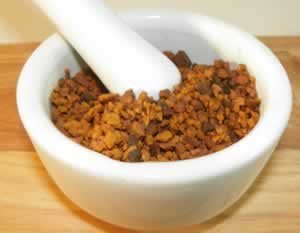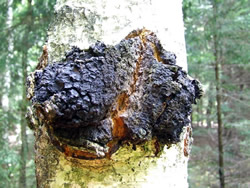Chaga Inonotus obliquus

Chaga Mushroom
- Common Names
- Chaga Mushroom , Cinder conk, Birch mushroom
- Botanical Name
- Inonotus obliquus
- Family
Medicinal Uses & Benefits of Chaga Mushroom
![]() How to Use|
Side Effects |
Plant & Garden|
How to Use|
Side Effects |
Plant & Garden|
- Medicinal Uses: * Cancer Prevention
* Immune
* Longevity Tonics
- Properties: * Analgesic * Antioxidant * AntiViral * Immunostimulant
- Parts Used: Whole Mushroom
- Constituents: polysaccharides
How to Use: Chaga
Chaga mushrooms, or cinder conks, have been a staple of traditional medicine for centuries among the peoples of the boreal forests in Siberia, Asia and North America. They are used as a tonic and blood purifier. They belong to the Polypores, a group of mushrooms that grow on wood and may be the ancestors of most gilled mushrooms. Chaga and the similar reishi mushroom both have a reputation as tonics for longevity and health which are born out by recent scientific studies. These mushrooms show great promise for their anti-viral activities, immune response stimulation and anti-tumor effects that inhibit the spread of cancer cells. 1,2
Preparation Methods & Dosage :Chaga is most often drunk as a mushroom tea, but is also available as liquid extracts.
Chaga Remedies
Chaga Side Effects: None noted. Use with caution when pregnant, breastfeeding, and with small children.
Plant Description
Chaga is a mushroom, a parasitic fungal growth that looks like the charred remains of burned wood on the side of a birch tree. Chaga conks are somewhat rare, and are found in northern climates, predominantly in Poland, Western Siberia, and throughout North America. Unlike most mushrooms,Chaga mushrooms get their nutrients from living trees, rather than the forest floor, a process that most often unfortunately kills the host tree.
Regional Traditions :European * North America *
How to Grow Chaga
Wildcrafted.
In the forests of northern part of Canada medicinal conks are available for harvest from public lands. Economically marginalized communities in these areas could benefit from cooperative collection and extraction of these medicinal mushrooms. 3
History and Traditions & Folklore
Chaga was documented by Chinese herbalist Shen Nong in his herbal texts as early as the first century B.C.E. Russian folk medicine used chaga for ailments of the stomach, liver, and heart, as well as a tonic, blood purifier, and pain reliever. Chaga remains popular in Russia today, where it is sold as Befunigin, as a cancer cure. 1- Paul Stamets. "New Anti-viral Compounds from Mushrooms".
American Botanical Council
Many of these species are long-term residents of old growth forests, playing an essential role in nutrient recycling by decomposing aged trees. In a time when new anti-viral medicines are critically needed, mushrooms stand out as an untapped resource and deserve intensive studies.
- Wasser SP, Weis AL. "Medicinal properties of substances occurring in higher basidiomycetes mushrooms: Current perspectives (review)". International Journal of Medicinal Mushrooms. 1999;1:31-62.
American Botanical Council
Polysaccharides from mushrooms do not attack cancer cells directly, but activate different immune responses in the host. Immunomodulators increase the activity of macrophages (white blood cells that destroy pathogens) found in the mucous membranes of the body and the reticuloendothelial system, centered in the spleen, liver, and lymphoid tissues. Many mushroom polysaccharides have an ability to stimulate macrophage (scavenger cell) activity.
- Robert Rogers. "The Fungal Pharmacy: Medicinal Mushrooms of Western Canada" , Prairie Deva Press, 2006. Paperback; 234 pages. ISBN: 978-13581-4.












